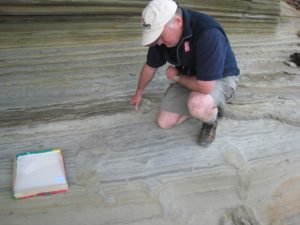 |
| Greg Browne. Image Julian Thomson @ GNS Science |
In New Zealand there is only one area (with six individual locations not far from each other) in which dinosaur footprints have been identified. This is in NW Nelson in the South Island. They were discovered and researched by Greg Browne, a sedimentologist at GNS Science who has spent many years doing geological fieldwork in the area. The first announcement of their discovery was in 2009 as shown in this video.
 |
| Dinosaur footprints near Rovereto, Italy. Image J Thomson |
When compared to the easily recognisable dinosaur trails that are found in other parts of the world, the structures that have been classified as footprints in New Zealand are not initially obvious. The photo shows an example from near Rovereto in northern Italy where each footprint is about 30 cm across.
 |
| Image Julian Thomson @ GNS Science |
In comparison, the New Zealand examples are irregular in shape and position. It took a lot of research and a process of elimination to be certain that these structures are indeed trace fossils of dinosaurs, rather than originating from another biological or mechanical cause..
In order to be able to point at a dinosaur origin for these impressions, there are several factors that have to be considered. As a starting point we can look at horses on a modern beach:
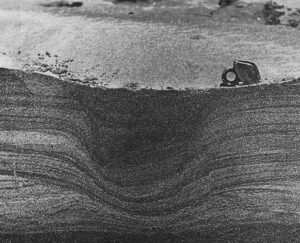 |
| Image: Van der Lingen, G.J. & Andrews, P.B |
This photo was taken by researchers who investigated horse hoof marks that were imprinted on a beach sand in New Zealand (from van der Lingen, G.J. & Andrews, P.B. 1979, Journal of Sedimentary Petrology). They carefully cut a vertical slice through the imprint to study the details of how the horizontal layers of sand were deformed by the weight of the passing animal. The hand lens shows the scale:
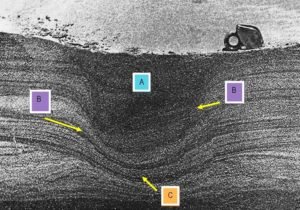 |
| Base image: Van der Lingen, G.J. & Andrews, P.B |
There are essentially three ways in which the original sediment has been affected:
(A) – Jumbled particles and blocks of sand have fallen into the depression made by the footprint.(B) The footprint has a clear vertical margin on either side(C) The sediment underlying the footprint has been compressed downwards.
It is most likely that these horse footprints were soon eroded after their formation in the late seventies, due to tides, storms, wind or even the action of shore creatures such as crabs, worms or shellfish. On the other hand, there is a small possibility that they were preserved quickly beneath a new layer of sand and are still intact beneath this protective covering.
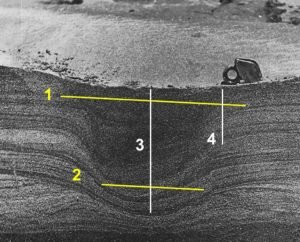 |
| Base image: Van der Lingen, G.J. & Andrews, P.B |
Over geological time, sediments such as these can become buried deeply, compressed into solid rock and later revealed by uplift and erosion at the modern land surface. In the case of the horse footprint, its appearence on the surface (in 2 dimensions) would then depend on the amount and angle of erosion. For example, if it is were eroded near to the top of the footprint (the level of line 1 in the photo) it would appear relatively large compared to if the erosion had removed most of the material, and only the lower part of the footprint were showing (line 2).
Similarly if a vertical section of the footprint were to be exposed, its size and appearance would differ depending on whether the section that was revealed represented the centre of the footprint (3) or its edge (4).
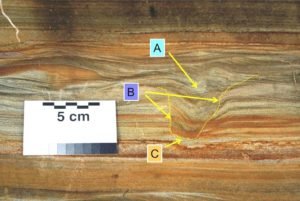 |
| Image Greg Browne @ GNS Science |
Here is an example of one of the footprints that Greg identified in the Upper Cretaceous rocks of Nelson. It shows similar features in cross section to the horse footprint (at approximately the same scale)- the infilling (A), the distinct margin (B) and the compressed underlying layers (C).
 |
| Image Greg Browne @ GNS Science |
Here is another example of a vertical slice through a footprint, with the dotted line highlighting the distinct margin of the structure:
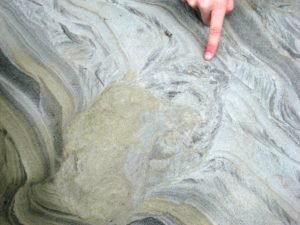 |
| Julian Thomson @ GNS Science |
This photo shows a footprint eroded horizontally. The heel has cut a sharp edge into the sediment at the back end of the feature (lower left), while the front has been compressed into ridges as the foot tipped forwards during locomotion (near finger).
Having confirmed these features as footprints being preserved in sediment from an intertidal environment, the question then arises as to whether animals other than dinosaurs could have made them. Having tackled this question over many years, Greg Browne worked through the following possible examples and discounted them for the reasons given:
- Fish feeding or resting traces: depth of penetration and lack of deformed strata below.
- Amphibian foot prints: unlikely to have an amphibian large enough.
- Bird foot prints: bird would have to be large and heavy.
- Mammals: the only pre-Pleistocene mammals known from New Zealand are Early Miocene mouse-like fossils. Evidence throughout the world indicates that Cretaceous mammals were small, and did not develop into large animals until after the end of the Cretaceous extinction event and the demise of the dinosaurs.
- Reptile foot prints: dinosaurs: only dinosaurs would be of sufficient size and weight to have generated these deformed point source compression structures.
Recently, with funding from the Unlocking Curious Minds Fund of the Ministry for Business, Innovation and Employment (MBIE), a team from GNS Science were assisted by teachers and students of Collingwood Area School, to clean up a large rock slab in the search for more dinosaur footprints.
With a lot of hard work, involving cleaning mud
off the rocks with buckets of water, brooms and shovels, some hitherto unseen dinosaur footprints were revealed for the first time since the Cretaceous Period, about 70 million years ago.
Here are some quotes from our assistants:
“It was a wonderful once-in-a-lifetime opportunity to work with a team of scientists and look at a real dinosaur footprints.”
“It was an honor and very humbling knowing that we were the first people to see these footprints in 70,000,000 years.”
“It was an incredible opportunity. We were able to work alongside the scientists and they taught us about how to identify the footprints and showed us how they took peels of them.”
This video tells the story of the expedition:
For more information about this Dinosaur Footprints project, including newsletter updates, click here.





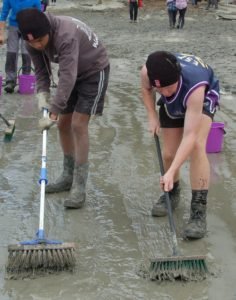

Dinosaur footprints are epic! this is the first time im seeing real ones and it drives me crazy to think they were this big once upon a time. thanks for sharing and stay awesome.